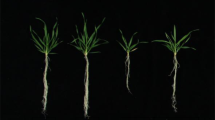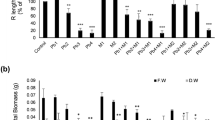Abstract
Being regulators of growth, both spermidine (Spd) and melatonin (Mel) are involved actively in the modulation of abiotic stress responses of plants. Hence, the present study was aimed to scrutinize the possible involvements of Spd and Mel in alleviation of fluoride ion (F−)-induced injuries in Cajanus cajan L. Seeds of C. cajan L. were exposed to 1) control, 2) F−, 3) Spd, 4) Spd + F−, 5) Mel and 6) Mel + F− for five days. The results unveiled that F− treatment caused inhibited growth (radicle length and dry mass accumulation), protein content, genomic template stability, membrane stability index, and free radical scavenging capacity, but enhanced the levels of cell death, active oxygen species (AOS), malondialdehyde, lipase, protein carbonylation, and DNA polymorphism. Moreover, F− toxicity elevated the concentrations of endogenous proline, ascorbic acid, and glutathione, and altered the isoenzyme profiles and gene expressions of stress responsive enzymes (superoxide dismutase, catalase, ascorbate peroxidase, and glutathione-S-transferase). In contrast, exogenous supplementation of Spd and Mel alleviated the deleterious effects of F−, consequently improved growth, free radical scavenging capacity, and accumulations of protein, proline, ascorbic acid, and glutathione in C. cajan L. Additionally, application of Spd or Mel also improved the isoenzyme profiles and gene expressions of stress responsive enzymes, and genomic template stability, thereby reduced cell death, AOS, lipid peroxidation, lipase activity, and DNA polymorphism in stressed tissues. The present study concludes that Spd and Mel, particularly Mel, alleviated the adverse impacts of F− by improving antioxidant machinery and genomic template stability.






Similar content being viewed by others
References
Agarwal S, Khan S (2016) Sodium fluoride (NaF) induced changes in growth and DNA profile of Vigna radiata. Plant Sci Today 3:1–5
Ahmad P, Abd Allah EF, Hashem A, Sarwat M, Gucel S (2016) Exogenous application of selenium mitigates cadmium toxicity in Brassica juncea L. (Czern & Cross) by up-regulating antioxidative system and secondary metabolites. J Plant Growth Regul 35:936–950
Bałabusta M, Szafranska K, Posmyk MM (2016) Exogenous melatonin improves antioxidant defense in cucumber seeds (Cucumis sativus L.) germinated under chilling stress. Front Plant Sci 7:1–12
Bates LS, Waldren RP, Teare ID (1973) Rapid determination of free proline for water stress studies. Plant Soil 39:205–207
Batir MB, Candan F, Buyuk I, Aras S (2015) The determination of physiological and DNA changes in seedlings of maize (Zea mays L.) seeds exposed to the waters of the Gediz River and copper heavy metal stress. Environ Monit Assess 187:169–178
Beauchamp C, Fridovich I (1971) Superoxide dismutase: improved assay and an assay applicable to acrylamide gels. Anal Biochem 44:276–287
Bradford MM (1976) A rapid and sensitive method for the quantification of microgram quantities of protein utilizing the principle of protein-dye binding. Anal Biochem 72:248–254
Cai S-Y, Zhang Y, Xu Y-P, Qi Z-Y, Li M-Q, Ahammed GJ, **a X-J, Shi K, Zhou Y-H, Reiter RJ, Yu J-Q, Zhou J (2017) HsfA1a upregulates melatonin biosynthesis to confer cadmium tolerance in tomato plants. J Pineal Res 62:e12387
Chance M, Maehly AC (1955) Assay of catalases and peroxidases. Methods Enzymol 2:764–817
Chandrakar V, Naithani SC, Keshavkant S (2016) Arsenic induced metabolic disturbances and their mitigation mechanisms in crop plants: a review. Biologia 71:367–377
Chandrakar V, Yadu B, Meena R, Dubey A, Keshavkant S (2017a) Arsenic-induced genotoxic responses and their amelioration by diphenylene iodonium, 24-epibrassinolide and proline in Glycine max L. Plant Physiol Biochem 112:74–86
Chandrakar V, Parkhey S, Dubey A, Keshavkant S (2017b) Modulation in arsenic-induced lipid catabolism in Glycine max L. using proline, 24-epibrassinolide and diphenylene iodonium. Biologia 72:292–299
Choudhary SP, Kanwar M, Bhardwaj R, Yu JQ, Tran LSP (2012) Chromium stress mitigation by polyamine-brassinosteroid application involves phytohormonal and physiological strategies in Raphanus sativus L. PLoS ONE 7:e33210. https://doi.org/10.1371/journal.pone.0033210
Diao Q, Song Y, Qi H (2015) Exogenous spermidine enhances chilling tolerance of tomato (Solanum lycopersicum L.) seedlings via involvement in polyamines metabolism and physiological parameter levels. Acta Physiol Plant 37:1–15
Doyle JJ, Doyle JL (1987) A rapid DNA isolation procedure for small quantities of fresh leaf tissue. Phytochem Bull 19:11–15
Gadi BR, Verma P, Ram A (2012) Influence of NaF on seed germination, membrane stability and some biochemical content in Vigna seedlings. J Chem Biol Phys Sci 2:1371–1378
Griffith OW (1980) Determination of glutathione and glutathione disulfide using glutathione reductase and 2-vinylpyridine. Anal Biochem 106:207–212
Hasan MK, Ahammed GJ, Yin L, Shi K, **a X, Zhou Y, Yu J, Zhou J (2015) Melatonin mitigates cadmium phytotoxicity through modulation of phytochelatin biosynthesis, vacuolar sequestration, and antioxidant potential in Solanum lycopersicum L. Front Plant Sci 6:1–14
Hemalatha S, Lalitha P, Arulpriya P (2010) Antioxidant activities of the extracts of the aerial roots of Pothos aurea (Linden ex Andre). Der Pharma Chem 2:84–89
Hodges DM, DeLong JM, Forney CF, Prange RK (1999) Improving the thiobarbituric acid-reactive-substances assay for estimating lipid peroxidation in plant tissues containing anthocyanin and other interfering compounds. Planta 207:604–611
Iannelli MA, Pietrini F, Fiore L, Petrilli L, Massacci A (2002) Antioxidant response to cadmium in Phragmites australis plants. Plant Physiol Biochem 40:977–982
Itaya K, Ui M (1965) Colorimetric determination of free fatty acids in biological fluids. J Lipid Res 6:16–20
Levine A, Tenhaken R, Dixon R, Lamb CJ (1994) H2O2 from the oxidative burst orchestrates the plant hypersensitive disease resistance response. Cell 79:583–593
Li Z, Peng Y, Zhang XQ, Pan MH, Ma X, Huang LK, Yan YH (2014) Exogenous spermidine improves water stress tolerance of white clover (Trifolium repens L.) involved in antioxidant defence, gene expression and proline metabolism. POJ 7:517–526
Li M-Q, Hasan MK, Li C-X, Ahammed GJ, **a X-J, Shi K, Zhou Y-H, Reiter RJ, Yu J-Q, Xu M-X, Zhou J (2016) Melatonin mediates selenium-induced tolerance to cadmium stress in tomato plants. J Pineal Res 61:291–302
Livak KJ, Schmittgen TD (2001) Analysis of relative gene expression data using real-time quantitative PCR and the 2-δCT method. Methods 25:402–408
Marklund S, Marklund G (1974) Involvement of the superoxide anion radical in the autoxidation of pyrogallol and a convenient assay for superoxide dismutase. Eur J Biochem 47:469–474
Mittler R, Zilinskas BA (1993) Detection of ascorbate peroxidase activity in native gels by inhibition of the ascorbate-dependent reduction of nitroblue tetrazolium. J Anal Chem 212:540–546
Mukherjee SP, Choudhuri MA (1983) Implications of water stress-induced changes in the levels of endogenous ascorbic acid and hydrogen peroxide in Vigna seedlings. Physiol Plant 58:166–170
Nahar K, Rahman M, Hasanuzzaman M, Alam MM, Rahman A, Suzuki T, Fujita M (2016) Physiological and biochemical mechanisms of spermine-induced cadmium stress tolerance in mung bean (Vigna radiata L.) seedlings. Environ Sci Pollut Res 23:21206–21218
Nair PMG, Chung IM (2015) Physiological and molecular level studies on the toxicity of silver nanoparticles in germinating seedlings of mung bean (Vigna radiata L.). Acta Physiol Plant 37:1–11
Nakano Y, Asada K (1981) Hydrogen peroxide is scavenged by spinach chloroplasts. Plant Cell Physiol 22:867–880
Panda SK, Matsumoto H (2010) Changes in antioxidant gene expression and induction of oxidative stress in pea (Pisum sativum L.) under Al stress. Biometals 23:753–762
Ricci G, Bello ML, Caccur AM, Galiazzo F, Federici G (1984) Detection of glutathione transferase activity on polyacrylamide gels. Anal Biochem 143:226–230
Sang QQ, Shu S, Shan X, Guo SR, Sun J (2016) Effects of exogenous spermidine on antioxidant system of tomato seedlings exposed to high temperature stress. Russ J Plant Physiol 63:645–655
Sarafi E, Tsouvaltzis P, Chatzissavvidis C, Siomos A, Therios I (2017) Melatonin and resveratrol reverse the toxic effect of high boron (B) and modulate biochemical parameters in pepper plants (Capsicum annuum L.). Plant Physiol Biochem 112:173–182
Schopfer P, Plachy C, Frahry G (2001) Release of reactive oxygen intermediates (superoxide radicals, hydrogen peroxide, and hydroxyl radicals) and peroxidase in germinating radish seeds controlled by light, gibberellin, and abscisic acid. Plant Physiol 125:1591–1602
Turk H, Erdal S, Genisel M, Atici O, Demir Y, Yanmis D (2014) The regulatory effect of melatonin on physiological, biochemical and molecular parameters in cold-stressed wheat seedlings. Plant Growth Regul 74:139–152
Velikova V, Yordanov I, Edreva A (2000) Oxidative stress and some antioxidant systems in acid rain-treated bean plants. Plant Sci 151:59–66
Wang LY, Liu JL, Wang WX, Sun Y (2016) Exogenous melatonin improves growth and photosynthetic capacity of cucumber under salinity-induced stress. Photosynthetica 54:19–27
Woodbury W, Spencer AK, Stahmann MA (1971) An improved procedure using ferricyanide for detecting catalase isozymes. Anal Biochem 44:301–305
Xu W, Cai S-Y, Zhang Y, Ahammed GJ, **a X-J, Shi K, Zhou Y-H, Yu J-Q, Reiter RJ, Zhou J (2016) Melatonin enhances thermotolerance by promoting cellular protein protection in tomato plants. J Pineal Res 61:457–469
Yadu B, Chandrakar V, Keshavkant S (2016) Responses of plants towards fluoride: an overview of oxidative stress and defense mechanisms. Fluoride 49:293–302
Yadu B, Chandrakar V, Meena RK, Keshavkant S (2017a) Glycinebetaine reduces oxidative injury and enhances fluoride stress tolerance via improving antioxidant enzymes, proline and genomic template stability in Cajanus cajan L. S Afr J Bot 111:68–75
Yadu S, Dewangan TL, Chandrakar V, Keshavkant S (2017b) Imperative roles of salicylic acid and nitric oxide in improving salinity tolerance in Pisum sativum L. Physiol Mol Biol Plants 23:43–58
Yuan L, Zhu S, Li S, Shu S, Sun J, Guo S (2014) 24-Epibrassinolide regulates carbohydrate metabolism and increases polyamine content in cucumber exposed to Ca(NO3)2 stress. Acta Physiol Plant 36:2845–2852
Zhang Y, Zhang L, Hu XH (2014) Exogenous spermidine-induced changes at physiological and biochemical parameters levels in tomato seedling grown in saline-alkaline condition. Bot Stud 55:1–8
Zhou ZS, Guo K, Elbaz AA, Yang ZM (2009) Salicylic acid alleviates mercury toxicity by preventing oxidative stress in roots of Medicago sativa. Environ Exp Bot 65:27–34
Acknowledgements
The authors would also like to thank Defense Research & Development Organization, New Delhi (DRDE/TC/05414/Proj/TASK-220/16 Dated June 27, 2016) and Department of Science & Technology, New Delhi (No. DST/INSPIRE Fellowship/2013/791, dated 23.01.2013), for awarding fellowships to Bhumika Yadu and Vibhuti Chandrakar respectively. The authors are also grateful to Department of Science & Technology, New Delhi, for financial support through DST-FIST scheme (Sanction No. 2384/IFD/2014-15, dated 31.07.2014) sanctioned to the School of Studies in Biotechnology. The authors are also grateful to Department of Sciences and Technology, New Delhi, funded [IR/SO/LU/0008/2011 (SERB)] National Centre for Natural Resources, Pt. Ravishankar Shukla University, Raipur, for providing necessary RT-PCR facility.
Author information
Authors and Affiliations
Corresponding author
Rights and permissions
About this article
Cite this article
Yadu, B., Chandrakar, V., Meena, R.K. et al. Spermidine and Melatonin Attenuate Fluoride Toxicity by Regulating Gene Expression of Antioxidants in Cajanus cajan L.. J Plant Growth Regul 37, 1113–1126 (2018). https://doi.org/10.1007/s00344-018-9786-y
Received:
Accepted:
Published:
Issue Date:
DOI: https://doi.org/10.1007/s00344-018-9786-y




